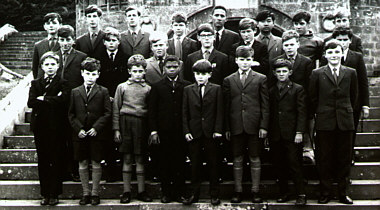Quantock School History
The foundation of Quantock School
In 1953 the Cotham High School for Boys was founded by David T. Peaster, a graduate of the College of St. Mark and St. John in London. Located in the city of Bristol, Cotham was a private day school and had a small, tight-knit community - as well as a traditional approach to schooling that was slowly beginning to erode under the weight of the wave of post-war educational changes. Following the purchase of Lord Taunton's Over Stowey lodge in 1962 by the Peaster family, the process of moving Cotham High to the Quantock Hills began. Although according to various editions of the prospectus Quantock School opened in 1962, in reality the first pupils, all from Cotham High, arrived in 1964. The coat of arms of Lord Taunton - which can be seen in the Lodge's stained-glass windows - was soon adopted as the official school crest, as was the highly appropriate Latin motto Passibus Citis Sed Novis - 'into new steps with confidence'.
From reading the earlier editions of the prospectus, one might think that Cotham was simply shifted root and branch to the Quantocks; this was actually not the case, as David Peaster - known as 'Ben' to the pupils at the time, appointed Mr. Ken 'Basil' Burns as Headmaster of Cotham High. Although Mr. Burns was a good Headmaster and teacher - he taught French and Spanish - he lacked the selling side which was essential with a private school to keep the numbers of pupils there. The writing was therefore pretty much on the wall; Cotham High School stayed open until 1966 when it had to close due to a lack of pupils. David Peaster was unable to promote and run both schools so Cotham suffered, hence the closure. What didn't help Cotham was the fact that David Peaster used to take books and other educational supplies from Cotham to supply Quantock.
Quantock School opened with only three pupils, Lawrence Booth, Anthony Budget and Richard Williams, all of whom came from Cotham; the initial staff consisted of Headmaster David Peaster, Deputy Headmaster Gerald Warriner, David Peaster's brothers Phillip (mathematics and woodwork) and Keith (odd jobs), Keith Peaster's wife (laundry), David Peaster's father 'Pop' Peaster (cleaner) and a cook. At this time there was no on-site matron.

Above: The pupils of Quantock School in 1964. The first three pupils to arrive at the school were Anthony Budget (back row, fourth from left), Richard Williams (middle row, centre) and Laurie Booth (middle row, second from right).
The Lodge's previous role as a TB hospital was pretty much in evidence; the taps had long handles and the previous occupiers had left an x-ray machine in a room on the ground floor. David Peaster soon sold this machine to help with the finances. The development of Quantock School was assisted further by the closure of a local boarding school, many of whose pupils transferred to the new school.
Not long after the school opened one of the pupils, Lawrence Booth, fell ill. As there was no matron or nurse on site, he was looked after by one of the other pupils, Richard Williams. This situation led to Deputy Headmaster Gerry Warriner deciding that the school needed an on-site matron; this led to one of the new pupils, William Beaumont, suggesting his sister Jane Beaumont who was a qualified State Registered Nurse. She was given the job, and soon afterwards married David Peaster. She remained as the school's Matron until its closure in 1998.
Almost from its foundation the school was very popular with those who were involved in some way or another with overseas travel; many of the pupils who attended Quantock School had been the children of diplomats and and businessmen serving abroad, although the vast majority were from forces families - the result of Quantock School being on the Armed Forces approved list.
While the school ethos itself engendered a family atmosphere and a genuine "community" feeling, this was no doubt enhanced by the fact that the vast majority of those who attended the school came from very similar backgrounds. It was this combination of things that made Quantock School something of an unique educational establishment.
Quantock School was founded on a traditional set of values that were at the time strongly appreciated by society as a whole; the Daily Express described Quantock as 'Britain's newest Public School', while in 1965 - a mere three years after Quantock's foundation - it was described by the Gordonstoun Record as 'the Gordonstoun of the West'. (1981 Prospectus, p.9). This burgeoning reputation attracted those that had a close association with the style and approach promoted by Quantock School - and very soon it was on the exclusive list of schools recommended by the Armed Services, which were to provide Quantock with the majority of its pupils over the coming two decades.